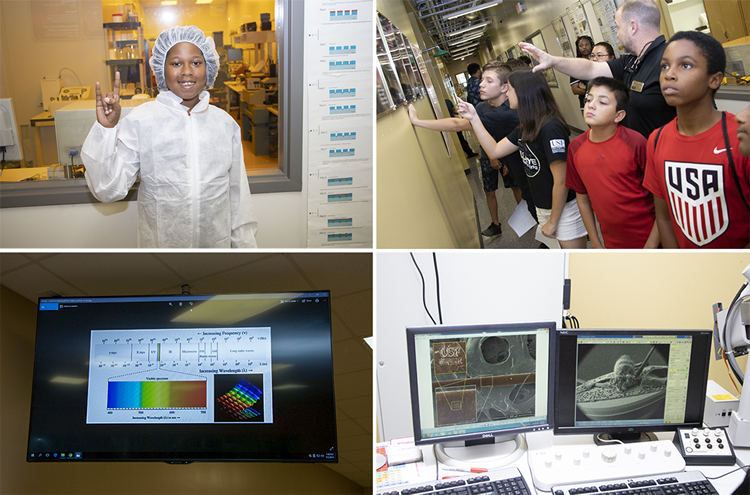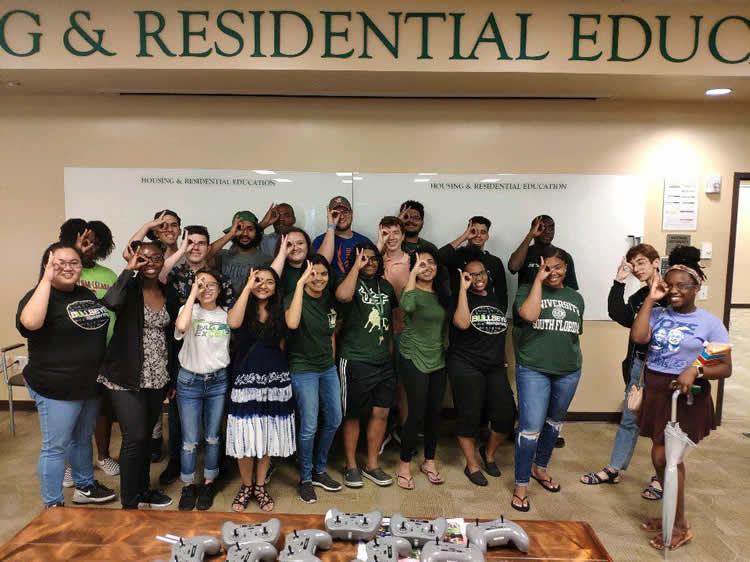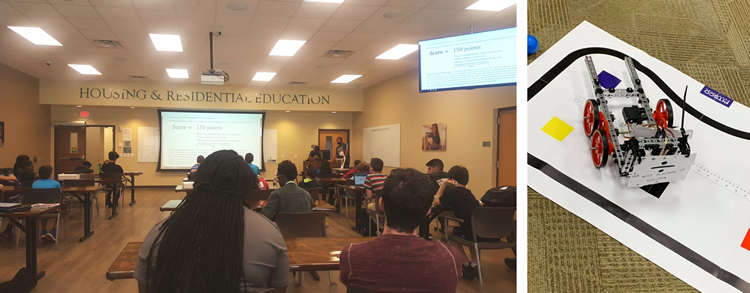Bulls-EYE Mentoring Puts Tampa Middle Schoolers on Path to Engineering
Summer for most middle schoolers rarely involves laboratory tours, but about 40 Tampa Bay middle schoolers from the USF Bulls-EYE Mentoring program spent some of their summer break learning about nanotechnology at the USF Nanotechnology Research and Education Center this July.
The students’ tour of the center taught them just how tiny a nanometer is, the way many parts for consumer electronics are made, how things look under a scanning electron microscope and about the physics behind light and color. They also got to try on a few cleanroom suits.

From top left to bottom right: 1) A Bulls-EYE Mentoring enrollee learns about proper cleanroom attire for manufacturing microelectronics. 2) Students are introduced to a variety of nanotechnology facts and concepts. 3) Supplementing the physical tour of the Nanotechnology Research and Education Center are lessons on the visible light spectrum, luminescence, structural color and chemical color. 4) Visiting mentees are shown images from a scanning electronic microscope, including the USF logo patterned onto a human hair and a scan of a spider.
The trip was one part of students’ curriculum in the Bulls-EYE Mentoring program, a free, five-week STEM-focused summer program that introduces Hillsborough County middle schoolers to a variety of engineering disciplines and skillsets. The program formed its first cohort in the summer of 2015 and has welcomed more than 200 members to date. This year’s group featured about 45 students.
Bulls-EYE Mentoring received a grant in 2014 from tech company philanthropy Motorola Solutions Foundation to get started, and the program was awarded a National Science Foundation grant in 2018. Bulls-EYE Mentoring is directed by USF Mechanical Engineering faculty Jonathan Gaines, Ph.D., who also created the program.
“One thing that makes our program unique is that each week is focused on students’ development,” Gaines said. “At week four, we like to do a tour on campus so students can plant their feet in what’s possible in engineering and in STEM.”
He said the first part of the program focuses on team building and developing students’ engineering group dynamics. This includes an induction ceremony at the start of the program where new enrollees are welcomed by repeat students and mentors. The personal development of students is also celebrated throughout the program as students reflect on completed projects and plan for future ones.
During the five-week program, students complete three main engineering design projects in increasingly shorter intervals. Gaines said students have more than two weeks to finish the first project, about 10 days to work on the second and three or four days for the third. The program concludes with a mini graduation ceremony that gives students a chance to look back and see how far they’ve come since the start of the summer.

Bulls-EYE Summer 2019 mentors, program coordinators and junior mentors took an end-of-summer group photo. (Picture provided by Briana Nguyen)
This year’s three projects focused on robotics and let students build controllable robots to complete challenges with, as well as robots that could automatically follow the edge of a wall and small battle bots with moving parts to compete with each other. At the end of the summer, students wrote letters to their mentors about their experiences and how the program helped them develop their STEM skills.
Bulls-EYE mentors consist of USF engineering undergrads as well as high schoolers who graduated from the program at least once in middle school and want to come back to teach future students.
“Our retention levels are incredible — they come back every single summer,” said USF chemical engineering senior and Bulls-EYE head program coordinator Ahmirah Muhammad. “We’re looking to expand right now because we get kids who graduate from middle school and don’t want to leave. So once they age out, we have them come back to mentor and they’re able to get Bright Futures hours over the summer.”
Muhammad said she became a mentor because going into college she always knew she wanted an opportunity to benefit others, especially one that would allow her to help create jobs for Tampa’s black community and to become a role model for black girls throughout Tampa Bay.
“There’s not a lot of black girls who grow up to be engineers, and I definitely want to be a motivation like all the black women engineers before me who made me want to put myself in this position to be a role model for others,” she said.
Muhammad has spent three years with the program, and as head program coordinator this summer, she worked with a team of coordinators to create the program’s curriculum, communicate with parents of enrollees and communicate with mentors teaching the program’s sixth, seventh and eighth graders.
One of her favorite moments in the program is when students almost ready to give up on their projects not only stick with them and finish but go from unmotivated to wanting to take on additional projects.
“The resilience from these students is honestly phenomenal and inspiring that they’re still able to get up each day even though they may have a rough home life,” she said. “They may not be eager about the program at first, but they’re increasingly showing every day that they’re thinking, ‘Maybe I can get this.’ I’m very invested in my students, and I’m going to show them why this is the best place for them to be right now.”
While this year’s tour of NREC wasn’t the first time Bulls-EYE students had seen a lab, it was the first time Ph.D. students signed up to be involved with the program. The five Ph.D. students, as well as three other students who helped facilitate the tour and acted as mentors, were all students from the research group of mechanical engineering professor Michael Cai Wang.
While this was Wang’s first involvement with the program, he said he wants students from his USF nanomanufacturing lab — N3ML — to participate in Bulls-EYE curriculum for every future summer. He’s especially interested in extending the pipeline of students that can stay active in the program and thinks it’s feasible for a student to maintain involvement with Bulls-EYE from middle school all the way to the completion of a Ph.D. program.

Bulls-EYE founder Jonathan Gaines, Ph.D., taught a session during the program this summer on programming robots like the one pictured. (Left picture provided by Kéto Nord Hodges and right picture provided by Briana Nguyen)
“Instead of doing some high school summer job like fast food or retail, they’re coming back to the camp to mentor the younger kids, and they’re also doing cutting-edge research,” he said. “That builds a lasting identity in these kids where they can think, ‘Hey, I can do science. I can do engineering.’ More importantly, they have a cohort of friends they’ve built over multiple summers … Then when the time comes around 11th or 12th grade they’re thinking, ‘I don’t know where I want to go for college, but my friend’s been in Bulls-EYE at USF.’ … It’s like an alumni support network of Bulls-EYE students.”
Wang said the program is well positioned to act as a long-term pipeline for attracting future USF engineers. Involvement in Bulls-EYE conditions participants to an academic research environment and creates a mindset for the bigger picture of the opportunities available through an engineering degree. If they have a rough midterm or need to retake a class, he said, they won’t become disheartened with their entire programs because they know finishing their degrees means continuing their academic careers and meeting their long-term professional goals.
“If you were to do research starting from ninth grade until your senior year, that’s 7 years of research, which is just as long if not longer than a Ph.D.,” he said. “When they come to USF, they’re going to feel at home. They have a lab or research group they belong to, Ph.D. students they can reach out to and a faculty mentor they can trust.”
Gaines said the program also serves as a way to better integrate USF into the surrounding Tampa community by providing opportunities to residents while making the work of its faculty more accessible to the public.
“We have a lot of universities in metropolitan areas around the United States, and it’s important that universities are part of their communities,” he said. “Sometimes a university can find itself removed from where it is, and any time you have a quality institution embedded within a community, the institution should want to build the community up and improve the community.
First enrolled in Bulls-EYE in sixth grade, Hillsborough County high school sophomore and Bulls-EYE junior mentor Daniel Carvajal said the five years he spent with the program helped him further his childhood interests in programming and robotics.
“I knew a bit about programming, but I didn’t know the mechanical side, and I really didn’t know about working as a team,” Carvajal said. “Before I would try to figure out everything by myself — just me and Google. That works sometimes, but a lot of times you really need other people to give you fresh ideas. Bulls-EYE allowed me to do that because we always worked in groups of three and four, and we relied on each other and made sure everyone did their own part.”
Carvajal’s father Rodrigo, a software engineer who studied computer science in Colombia, said he was impressed to see how the program gave his son such a broad introduction to different engineering disciplines and that Carvajal’s time in Bulls-EYE has benefitted his ability to work in teams during high school robotics competitions, take leadership roles like in marching band at school and mentor younger students.
“The first year of high school, he signed up for an after-school robotics program, and he was so happy Dr. Gaines showed him how to use gears in a robot at Bulls-EYE because then he knew more than many of the other kids in the club and was a natural leader,” he said. “He’s now involved in FTC competitions, and he’ll always remember Dr. Gaines for that.”
Carvajal said the group of friends he’s made through Bulls-EYE almost feels like a second family and that he intends to enroll at USF after graduating high school and wants to focus on computer science like his dad.
In the future, Bulls-EYE could expand further as a program with new grants, sister programs that focus on retaining high schoolers and new curriculum or community outreach events.
“I would like to add a junior mentor sister program for ninth and tenth graders that fortifies the pipeline a bit more,” Gaines said. “We’ve actually already piloted part of curriculum, which involved putting payloads on kites and was a partnership with NASA and some other education research partners.”
“I would love to see the program physically go out into the community,” Muhammad said. “I know that there are students who don’t have the opportunity to get dropped off every single day, so I’d like to go out to the schools and maybe do demonstrations so they can get that experience – even if it’s for a day – and they can have that light bulb go off in their heads.”
“Students are the ones powering our preeminence … and in the long-term, we want to build USF not just as a preeminent university but as a top research university in the nation,” Wang said. “Our outreach is to not only give every student a chance to see if this is the right path for them, but it’s also to show the community that their hard-earned tax dollars are … funding students and new inventions. For every dollar we don’t invest (into our students), someone else is, and that invention could happen somewhere else.”


